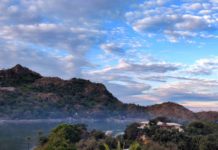With the Charm of PōHutukawa Forest, Breathtaking Summit, and Lava Caves, Rangitoto Awaits You.
Rangitoto Island is the newest island of Auckland, which appeared out of the ocean 600 years ago. The island is one of the major attractions for trekkers and best suited for a one-day trip. Here, you can explore the world’s largest pohutukawa forest, which is also known as the New Zealand Christmas tree.
The island has well-formed treks cutting through rugged lava fields. Passing through these fields in the shade of pohutukawa trees, you reach to Rangitoto Summit, providing you with a 360-degree view exhibiting Auckland City and Hauraki Gulf.
Rangitoto’s name had been derived from the phrase “Bleeding Skies” as it is formed due to volcanic eruption that would have filled the sky with flaming ashes.
History of Rangitoto Island
- The track to the summit and first wharf were built in the year 1897 and managed by Rangitoto Island Domain Board.
- The campsites were introduced in 1911, and in later years, approvals for the permanent buildings were provided. However, no further leases were given after 1937 for the next 20 years.
- In the 1980s, several baches were demolished. Today, the island houses no population, although some baches are restored due to their historical and architectural importance.
Things to Do at Rangitoto Island
1. Trek to Rangitoto Summit
- There are many walks on Rangitoto Island. Out of all, the Rangitoto Summit Climb is the most famous for the apparent reason; the topmost point on the island delivers you with panoramic views. In the west, comes into sight, the Hauraki Gulf and its emerald islands. Turning to the east, appear the Hunua Ranges.
- If you do not wish to do the trekking, you can choose to take the benefit of a guided tour on the 4WD road train.
- It takes an hour to reach the summit from Rangitoto wharf. Having gentle inclination and rugged lava surface, it is suggested to wear sturdy shoes.
- While trekking, informative boards are placed explaining the foregone history of the island’s volcanic eruptions and human activities.
2. Detour to Lava Caves
- The Lava Caves are at a distance of 200 meters from the Rangitoto Summit. It takes around thirty to forty-five minutes to reach there. It is advised to carry a torch if you wish to explore the caves at it could be dark inside.
3. Experience Sea Kayaking
- Tourists who are adventurous and wish to experience sea kayaking can choose to arrive at Rangitoto Island through guided kayaks. After absorbing the colours of sunset at the summit, you can paddle back to Auckland, experiencing eight km-long night kayaking.
4. Bird Watching at its Best
- Because of the continuous efforts of the Department of Conservation (DOC), restoration of forest spread in an area of 3,800 heaters took place. With the restoration, many bird species such as fantail, silvereye, morepork, bellbird, kakariki, etc. now inhabits the island. This has made bird-watching an essential activity at Rangitoto Island.
5. Rangitoto Baches
- There were many holiday homes built to promote tourism on the island. However, most of them are removed, and Back 38 is converted into a museum that is managed by Rangitoto Island Historic Conservation Trust. It is located adjacent to the Rangitoto Wharf.
Things to Consider While Visiting Rangitoto Island
- Visitors need to check their gears for pests as the island is made completely pest-free, and the DOC wishes to keep as it is.
- No pets are allowed on the island as a precaution to safeguard native species.
- Carry enough water and food supplies as there are no restaurants or shops available on the island.
- The temperature may change suddenly, so it is advised to keep warm wears along with you.
How to Reach Rangitoto Island
- There are frequent ferries available from Devonport Wharf and downtown Auckland which only takes 25 minutes to reach Rangitoto Island. You can take the first ferry from Auckland, which is at 9:15 am during working days, and 7:30 am on weekends. For returning from Rangitoto, the last ferry is at 3:30 pm on working days and 4:00 pm on weekends.
Best Time to Visit Rangitoto Island
- Weather at Rangitoto Island may change rapidly and unexpectedly. However, visiting the island during spring (September-November) and autumn (March-May) can be considered as the best. During this time, normally, the temperature remains between 19-26 degrees Celsius. Moreover, at this time, the tourist spots, including Rangitoto Island, are less crowded. You can also get cheaper flights and accommodation deals.
- If you visit Rangitoto Island during summer (December-February), make sure to keep your body covered to avoid wasp bites and carry the required medication.






